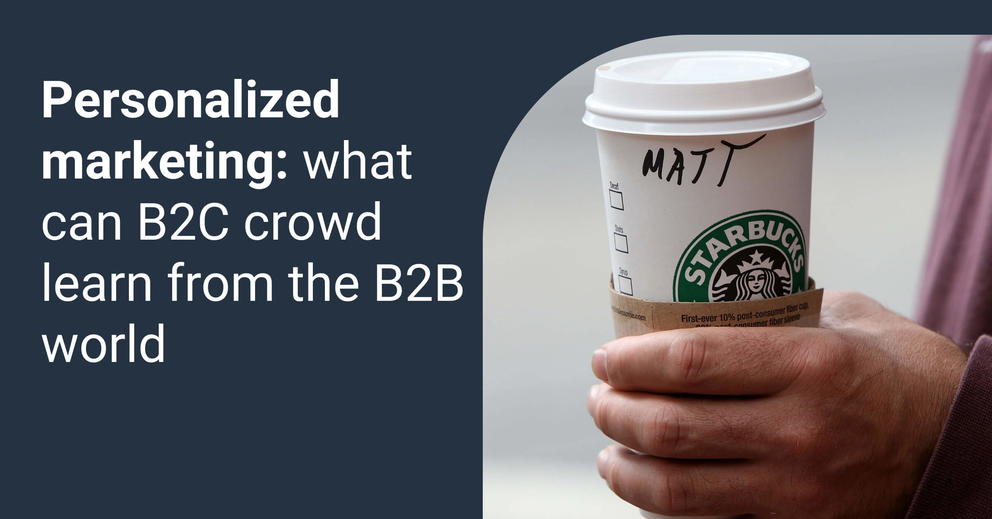Personalized marketing: what can B2C crowd learn from the B2B world
Personalized marketing has been trending recently, but its application started all the way back in the early days of social media advertising. Yet it’s B2B businesses that have been personalizing their products, services, customer and sales experiences - and not by their own choice. What can B2C crowd learn from that experience?

May 07 2021 ● 4 min read

Hi Matt,
Lovely to see you choosing to read this opinion piece. The world of marketing works in waves of trends, and the current tsunami is called personalized marketing. Sometimes it’s called one-to-one marketing. This term is used to describe marketing actions targeted at an individual rather than a broad audience.
Personalized marketing has been trending recently, but its application started all the way back in the early days of social media advertising. A good example was the BMW ad campaign in China in 2015. They chose WeChat - a popular messaging app and by this point a place you do everything on - and targeted customers whose profiles indicated they could afford luxury cars. Others were shown cheaper stuff, giving rise to dissatisfaction and calling the ad campaign to be in poor taste.
Now personalized marketing of this and higher calibre is everywhere. You just don’t notice it as much. Brands got much better at showing us the content we want to see and they spend increasingly more money on personalization. And there’s a good reason to do it.
Harvard Business Review ran an article on personalized marketing at scale. If done correctly, personalized marketing can:
- Increase marketing spend efficiency between 10 to 30%;
- Reduce the cost of acquisition by up to 50%;
- Increase revenues from 5 to 15%.
Those numbers are no laughing matter. They allow to achieve the ultimate goal every marketer has been screamed at for not attaining: do more for less.
So how are brands doing it?
Most big and small brands apply the DDDM strategy. A.k.a. Data-Driven Decision Making. The first step is to collect as much first-party data as possible, transform it into an immediately usable form and apply it in marketing, directed straight at the customer.
One of the most successful examples of personalized marketing is run by Starbucks. Their mobile app that allows customers to order and customize their coffees while earning rewards for each cup was responsible for 22% of all US monthly sales in 2017. That’s 22% out of $2.56 billion. The app uses data about each customer - their location, purchase history and preferences - to offer personalized rewards and deals. And people are digging it, happy to serve Starbucks with their data, which makes the app function even better. Starbucks app user base grew from 14.2 million in 2018 to a whopping 18.9 million users in 2020.
All of this wouldn’t be possible without data. Importantly, this wouldn’t be possible without first-party data. GDPR is bringing about colossal changes to 3rd party data collection, making it harder to achieve this level of personalization to absolutely everyone. But first-party data remains largely untouched - the legislation leaves it up to the individual to decide what amount of data they are comfortable giving away. There’s a lot of anxiety floating around among marketers about the changes in cookie policy. If you happen to be a marketer with a Shopify store, you probably need to find a good GDPR app to help with those data legislations.
What is not at all talked about is B2B businesses and their take on personalization.
So far, the discussion regarding personalized marketing has been revolving around the consumer. Yet it’s B2B businesses that have been personalizing their products, services, customer, and sales experiences - and not by their own choice.
According to the e-marketer, 21% of buyers find it important that the vendor provides insights into the buyer’s company and use them to personalize the sales process. Another 10% express the expectation of high-quality, personalized content provided by the vendor.
Due to the nature of B2B sales and marketing, it’s actually much easier to approach potential customers using the DDDM strategy.
Here’s an example of how B2B does it:
First, they collect the data about specific pain points their customers (potential or current) are experiencing. Whether through customer support or online complaint boards, they narrow downs the problems to offer valuable, accessible solutions, that could be done even better with their products or services.
MethodCRM has done a good job of this, providing tips & tricks videos, as well as actual problem solving propositions, aimed at their target audience. At Whatagraph, we did this too, helping our customers stay informed about the pros and cons of us vs our competitors - in video format (rise of video use in marketing is another story for another time).
So, what can B2C brands learn from the B2B crowd?
First of all, the concept of added value. Does every customer really need yet another app like Starbucks to engage with the brand? What value will the customer get by receiving yet another newsletter, albeit customised with offers interesting to them? Why should the customer care about the brand’s philanthropic endeavours, if they just want better prices and quicker customer service. B2B crowd’s target customers are notoriously busy, so B2B marketers have learned to waste as little of their time as possible, growing brand awareness in increasingly quick and valuable way.
Can the B2C crowd do it too? We’ll see when the 3rd party data collection will be truly gone and all that’s left is to ask for your customer’s attention directly.
Published on May 07 2021

WRITTEN BY
Indrė Jankutė-CarmaciuIndrė is a copywriter at Whatagraph with extensive experience in search engine optimization and public relations. She holds a degree in International Relations, while her professional background includes different marketing and advertising niches. She manages to merge marketing strategy and public speaking while educating readers on how to automate their businesses.